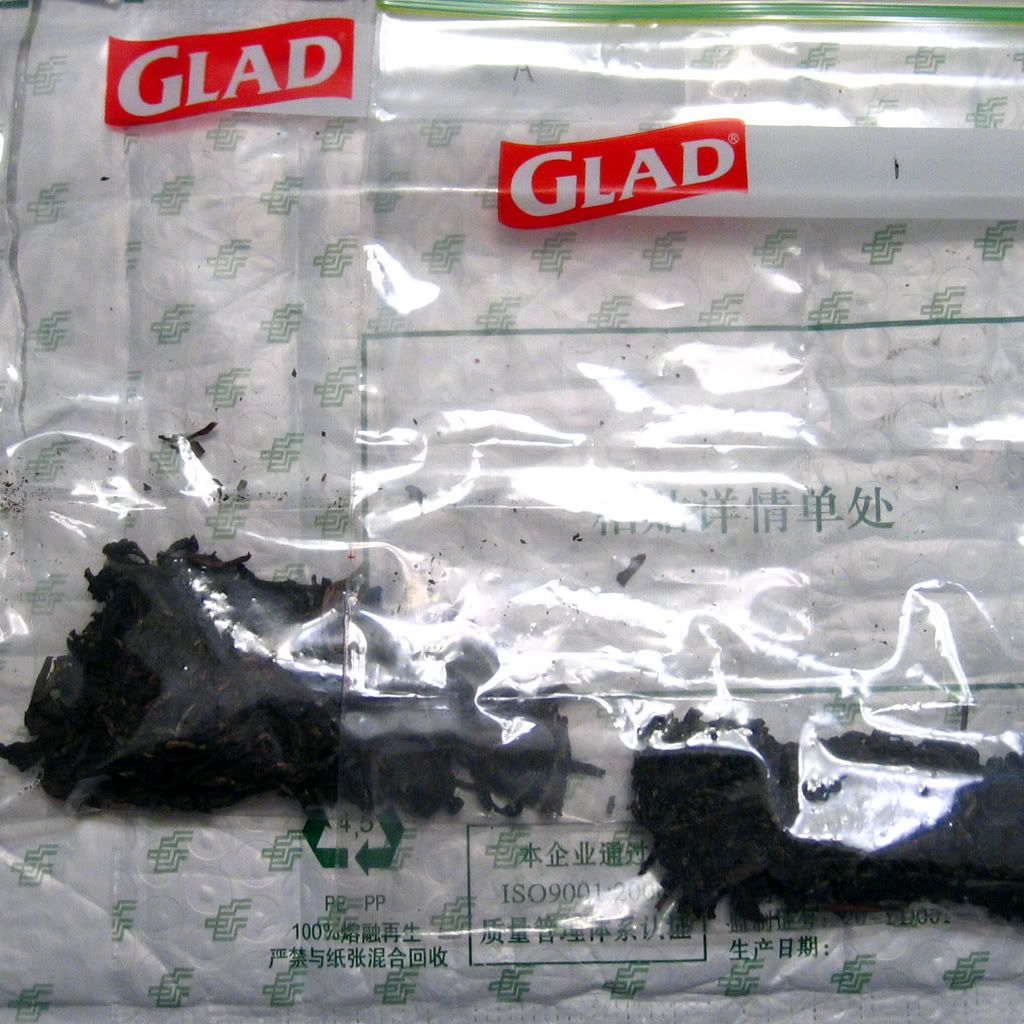Thank you for the pu’er samples! I have tasted them side-by-side, and I hope my findings are relevant to the collective opinion of those who also received these same samples. Please find my tasting notes and comments below. As with the tea samples that you have generously shared with me in the past, you have again challenged my taste buds and knowledge. This has been a relevant exercise, and if I am mistaken in my opinion, I can only attribute that to my lack of experience and shallow mental references.
Many thanks again and I hope to reciprocate in the near future.
Your friend in tea,
~ Phyll
 I am very glad to have received MarshalN’s pu’er samples, which traveled all the way from China to me in Los Angeles. It took its time getting here, however. Double glad that they arrived intact. Inscribed on the bags that hold the samples are letters A and I, separately. Purely on account of how I feel, I will refer to them as Glad A and Glad I below :)
I am very glad to have received MarshalN’s pu’er samples, which traveled all the way from China to me in Los Angeles. It took its time getting here, however. Double glad that they arrived intact. Inscribed on the bags that hold the samples are letters A and I, separately. Purely on account of how I feel, I will refer to them as Glad A and Glad I below :)As of writing this note, I have absolutely no idea about the vintages, producers and the exact origins of these samples.
[Brewing parameter for both samples: Crystal Geyser spring water, about 7gr in 100ml gaiwans, boiling water. 10s rinse, and then 10s, 10s, 10s, 15s, 15s]
Glad I
Dry leaves are dark green-colored with streaks of white, downy leaves. There are a little amount of brown leaves intermixed as well. It seems to me that the oxidation of the leaves is a bit inconsistent throughout. It looks like a one or two-year old tea. It smells fresh, plummy, fruity and a bit smoky. Quite inviting. After rinsing however, the aroma of the wet leaves becomes ashy…as in cigarette ash. Not a pleasant nose for me.
Excellent clarity. The brew comes out medium yellow-greenish color. It tastes bitter! From the 1st until its 5th infusion (I stopped after that), the tea tastes like a bitter vegetable concoction. In more ways than one, the taste reminds me of the time when I over brewed some cheap Taiping Houkui green tea, actually. The body is thin to medium and it has a mouth coating astringency. Not a pleasant tea to drink and I suppose this is an example of green tea parading as pu’er, although I am not 100% sure.
The spent leaves look quite appealing; mostly fresh green with some showing reddish hues. Most are half-chopped. Plantation leaves? 1 star (not good, not bad).

Glad A
Dry leaves range from being reddish-brown to very deep brown with some hairy white streaks here and there. I suspect that this tea was lightly “cooked” or at least mixed with some lightly cooked leaves. The aroma, when still dry, is like a deeper tone of smoke and plum, especially when compared to Glad I. And it also has a hint of light shu smell. Maybe my nose is playing a trick on me? After rinsing, the wet leaves give off the smell of talcum and tobacco.
The brew comes out slightly foggy, but still quite clear overall. Medium brownish-red color. This tea is certainly mellower, smoother and less green tasting than sample Glad I. In fact, there is hardly any bitterness in its taste. Each brew has soft astringency and plummy qualities to it. The aftertaste is quite pleasant and sweet, which further persuades me to attribute the tea to being the semi-shu kind.
Overall, though, the tea is rather simple, boring and lacks any character. Weak chaqi. It certainly is more enjoyable to drink this than sample Glad I, however.
Spent leaves look brownish-red overall. I set aside several leaves and stems that look the darkest among the bunch…and the more I inspect these few dark leaves/stems, the more convinced I am that this tea is a mix of lightly cooked leaves or contains cooked leaves for added smoothness and approachability for earlier consumption. 2 stars (mg).

4 comments:
Thanks for the notes Phyll.
Did you fix the saturation/colour balance of your pictures? Both sets of tea look darker than I remembered, and I am generous with leaves.
My camera is always set on "vivid" color setting, which I think is closer to how I see things in real life. :) I'll brew the leftover sample again and take the pics with the camera's default color setting.
Ok :)
By the way, I can tell you're straining yourself trying to remain polite about what you probably thought was toxic waste, especially with sample 1. Feel free to say what you want :)
I'd blame my upbringing. :)
All I was saying was, when brewed with the generic gongfu method for pu'er, Glad I tasted bitter like cheap, over brewed green tea. Maybe with less leaves and lower temperature the tea would fare better.
Post a Comment